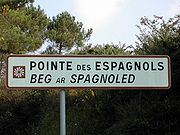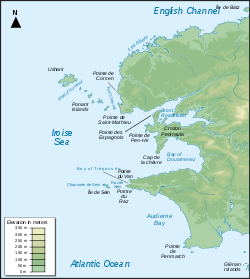
Pointe des Espagnols
Encyclopedia


Roscanvel
Roscanvel is a commune in the Finistère department of Brittany in north-western France.-Population:Inhabitants of Roscanvel are called in French Roscanvelistes.-See also:*Quélern*Communes of the Finistère department...
peninsula, an outgrowth of the Crozon peninsula closing off the roadstead of Brest
Roadstead of Brest
The roadstead of Brest is a roadstead or bay located in the Finistère department in Brittany in northwestern France. The surface area is about 180 km² . The port of Brest is located on its northern edge and one of the two French naval bases...
. It also marks the south-east limit of the goulet de Brest
Goulet de Brest
The Goulet de Brest is a 3 km long strait linking the roadstead of Brest to the Atlantic Ocean. Only 1.8 km wide, it is situated between the Pointe du Petit Minou and the Pointe du Portzic to the north and the îlot des Capucins and the Pointe des Espagnols to the south.At each turn of...
(the other limits are marked by pointe des Capucins, pointe du Petit Minou and pointe du Portzic).
Formed by a cliff that is more than 60m high, at whose summit and base are the remains of fortifications and barracks, the point reaches towards the north-east via the rocher de la Cormorandière, marked by a pole. The straight channel situated between the point and the rocher is the location for strong currents which affect the roadstead.
This strategic position, facing Brest, was already noted by the Duchy of Brittany, who sited a fortlet there in 1387 (now lost). In 1594, Spaniards landed here and were only dislodged after several battles - it was in this period that the cape first took on its present name.
Fortifications
.jpg)
- Fortlet (fortin) of the Dukes of Britanny (1387) - Disappeared
- Fortin des Espagnols (1594) - Disappeared
- Lower battery (1695) - built to plans by Vauban, on a platform re-using a mine at the bottom of the cliff
- Fort (1749) -
- Tour modèle n°1 (1812) - see Tour-modèle type 1811. Battlements destroyed by the Germans
- Underground battery (1888) - embrazures topped by a German blockhouse in 1942
- External battery (1890 - 1891)
- Magazines and underground battery (1890)
- DCA battery (1942)
External links
- Fort des Espagnols (general inventory)
- fortifications (photos)

